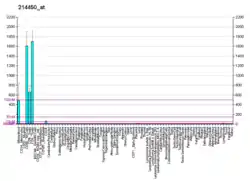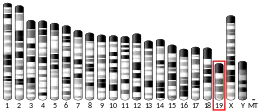组织蛋白酶W
组织蛋白酶W(英语:Cathepsin W)是一种在人体中由CTSW基因编码的蛋白质。[5][6][7]
| 组织蛋白酶W | |||||||||||||||||||||||||
|---|---|---|---|---|---|---|---|---|---|---|---|---|---|---|---|---|---|---|---|---|---|---|---|---|---|
| 識別號 | |||||||||||||||||||||||||
| 别名 | CTSW;, LYPN, cathepsin W | ||||||||||||||||||||||||
| 外部ID | OMIM:602364 MGI:1338045 HomoloGene:37471 GeneCards:CTSW | ||||||||||||||||||||||||
| |||||||||||||||||||||||||
| |||||||||||||||||||||||||
| RNA表达模式 | |||||||||||||||||||||||||
 | |||||||||||||||||||||||||
| 查阅更多表达数据 | |||||||||||||||||||||||||
| |||||||||||||||||||||||||
| 直系同源 | |||||||||||||||||||||||||
| 物種 | 人類 | 小鼠 | |||||||||||||||||||||||
| Entrez | |||||||||||||||||||||||||
| Ensembl | |||||||||||||||||||||||||
| UniProt | |||||||||||||||||||||||||
| mRNA序列 | |||||||||||||||||||||||||
| 蛋白序列 | |||||||||||||||||||||||||
| 基因位置(UCSC) | Chr 11: 65.88 – 65.88 Mb | Chr 19: 5.52 – 5.52 Mb | |||||||||||||||||||||||
| PubMed查找 | [3] | [4] | |||||||||||||||||||||||
| 維基數據 | |||||||||||||||||||||||||
该基因编码的蛋白质是半胱氨酸组织蛋白酶肽酶C1家族的成员,是一种半胱氨酸蛋白酶组织蛋白酶,可能在T细胞溶细胞活性的机制或调节中具有特定功能。编码的蛋白质被发现与自然杀伤细胞和细胞毒性T细胞的内质网内的细胞膜有关。该基因的表达被白细胞介素2上调。[7]
参见
参考文献
- GRCh38: Ensembl release 89: ENSG00000172543 - Ensembl, May 2017
- GRCm38: Ensembl release 89: ENSMUSG00000024910 - Ensembl, May 2017
- . National Center for Biotechnology Information, U.S. National Library of Medicine.
- . National Center for Biotechnology Information, U.S. National Library of Medicine.
- Linnevers C, Smeekens SP, Brömme D. . FEBS Lett. May 1997, 405 (3): 253–9. PMID 9108299. S2CID 45420314. doi:10.1016/S0014-5793(97)00118-X
 .
. - Wex T, Levy B, Smeekens SP, Ansorge S, Desnick RJ, Bromme D. . Biochem Biophys Res Commun. Aug 1998, 248 (2): 255–61. PMID 9675123. doi:10.1006/bbrc.1998.8954.
- .
阅读
- Gerhard DS, Wagner L, Feingold EA, et al. . Genome Res. 2004, 14 (10B): 2121–7. PMC 528928
 . PMID 15489334. doi:10.1101/gr.2596504.
. PMID 15489334. doi:10.1101/gr.2596504. - Meinhardt C, Peitz U, Treiber G, et al. . Biochem. Biophys. Res. Commun. 2004, 321 (4): 975–80. PMID 15358123. doi:10.1016/j.bbrc.2004.07.056.
- Zhang Z, Henzel WJ. . Protein Sci. 2005, 13 (10): 2819–24. PMC 2286551
 . PMID 15340161. doi:10.1110/ps.04682504.
. PMID 15340161. doi:10.1110/ps.04682504. - Strausberg RL, Feingold EA, Grouse LH, et al. . Proc. Natl. Acad. Sci. U.S.A. 2003, 99 (26): 16899–903. Bibcode:2002PNAS...9916899M. PMC 139241
 . PMID 12477932. doi:10.1073/pnas.242603899
. PMID 12477932. doi:10.1073/pnas.242603899  .
. - Buhling F, Kellner U, Guenther D, et al. . Biol. Chem. 2003, 383 (7–8): 1285–9. PMID 12437118. S2CID 23389714. doi:10.1515/BC.2002.144.
- Wex T, Bühling F, Wex H, et al. . J. Immunol. 2001, 167 (4): 2172–8. PMID 11490002. doi:10.4049/jimmunol.167.4.2172
 .
. - Wex T, Levy B, Wex H, Brömme D. . Adv. Exp. Med. Biol. Advances in Experimental Medicine and Biology. 2000, 477: 271–80. ISBN 0-306-46383-0. PMID 10849754. doi:10.1007/0-306-46826-3_29.
- Brinkworth RI, Tort JF, Brindley PJ, Dalton JP. . Int. J. Biochem. Cell Biol. 2000, 32 (3): 373–84. PMID 10716634. doi:10.1016/S1357-2725(99)00129-6.
- Wex T, Levy B, Wex H, Brömme D. . Biochem. Biophys. Res. Commun. 1999, 259 (2): 401–7. PMID 10362521. doi:10.1006/bbrc.1999.0700.
- Brown J, Matutes E, Singleton A, et al. . Leukemia. 1998, 12 (11): 1771–81. PMID 9823953. doi:10.1038/sj.leu.2401164
 .
.
This article is issued from Wikipedia. The text is licensed under Creative Commons - Attribution - Sharealike. Additional terms may apply for the media files.



